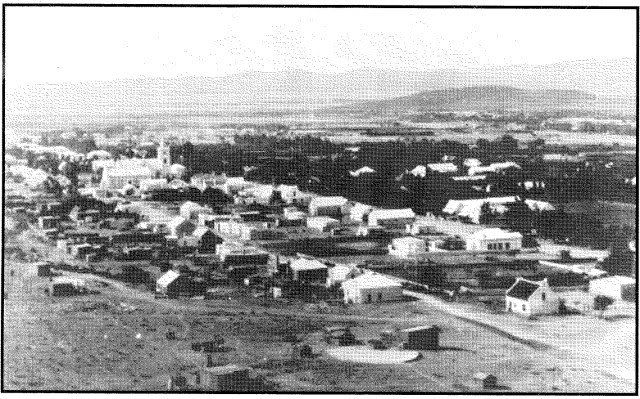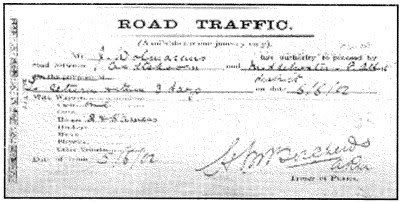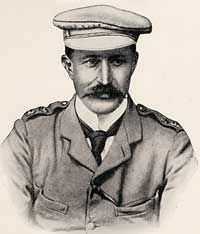.
A British garrison was established in Prins Albert under Capt. Dr. John Mearns. Their camp, Rooikamp, extended from the West side of Klip street to the Hill behind.
This is a photo of Prince Albert as it was after the Anglo-Boer War, circa 1909:

(Photo: Fransie Pienaar Museum)
During the war the local populace had to obtain a permit if they wished to move from one area to another. This is what the permits looked like:

(Anna Oosthuizen, 1902)
Twenty-five rebels from the Prince Albert area joined the Boer forces including four persons from Gamkaskloof (three from the family Cordier).
The church in Prince Albert was completed in 1865 and declared a national monument in 1988. During the war the British used the church as a fort. Sand bags were packed in front of the church and the tower was used as a lookout.

(Photo: Fransie Pienaar Museum)
The church today:

As reported earlier there were a few skirmishes between commando's and troops in the area. The Boers in the Cape Colony were clearly gaining the upper hand. The train wrecking and sabotage activities of Boer commandos deep behind English lines were an embarrassment and Kitchener had to do something. Never before had he taken such strong personal control of a campaign during the war.
In June he ordered Boers to be permanently banished from South Africa and he also ordered execution of Rebels, but in the second half of 1901 the British were still trying to catch the most successful Boer guerrillas on the run in the Southern Cape - Commandants Gideon Scheepers and Cornelius Lotter.

These two had long been a thorn in the side of the British. Scheepers had infested the southern districts for some months, and he had distinguished himself both by the activity of his movements and by the ruthless vigour of some of his actions.
The man detailed by General French to catch Lotter and Scheepers was Harry J. Scobell, a Colonel of the 5th Lancers.

Photo from this site.
Scobell was a distinguished officer who hunted the commandos of Scheepers and Lotter with vigor. More about Scobell in my Cornelius Lotter project.
9 October 1901: As usual the post was carried to Prince Albert Road by Jan Haak's post coach pulled by eight mules. After leaving the Hotel in Prince Albert he stopped at his halfway stop at Botterkraal where he suddenly was surrounded by Scheepers and his men. Everything of value was taken from the mail bags and the rest of the mail burned. Six of the eight mules were seized, leaving the post coach stranded.
10 October 1901: Scheepers' commando arrive at the farm Kopjeskraal about 20km from Botterkraal. The Commandant was seriously ill (probably appendicitis). He had fever, could no longer ride his horse and had to be helped into the house.
Having been pursued by the British for some time and to ill to travel any further Commandant Scheepers instructed his men too leave him behind on Kopjeskraal. His coloured groom, Hendrik, did not want to leave him. Another member of the commando, Karl Lehmkuhl (16 years old), broke down when they had to take leave of Scheepers.
Scheepers’ commando left the farmstead on 10 October 1901 in two groups, one under Hans Pypers and the other under Schalk Pypers.
The farm Kopjeskraal - This photo was taken by David Luttig around 1910:

(Photo: Fransie Pienaar Museum)
The house is in ruins today. It was destroyed in a flood.
The commando under Hans Pypers joined Comdt. van Deventer near Murraysburg. The other commando under Schalk Pypers joined Gen. Smuts at Willowmore.


Sources: Antjieskraal or Blood River Station; Boer War Autographs; The Great Boer War
.
No comments:
Post a Comment